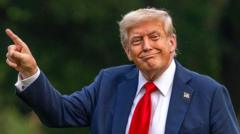The recent trade agreement between the United States and Japan, dubbed by President Donald Trump as the "largest trade deal in history," has raised eyebrows and prompted rigorous analysis regarding its implications for Asia and the global economy. While this claim may be overstated, the deal represents a significant shift following Trump's controversial Liberation Day tariffs implemented in April, which had previously stirred volatility in the markets and global trade dynamics.
Japan, the world's fourth-largest economy, heavily relies on imports for energy and food, and is a substantial exporter of electronics, machinery, and automotive products to the US. The threat of elevated tariffs by Trump had raised concerns among economists that Japan's economy could shrink, potentially leading to a recession. With the newly reduced tariffs, Japanese businesses can now trade more competitively in the US market, enabling them to navigate market uncertainties more effectively. The announcement has already fortified the yen against the dollar, empowering Japanese manufacturers with greater purchasing power for vital raw materials.
This agreement is particularly advantageous for Japan’s automotive industry, as it reduces the import tax on Japanese vehicles from 27.5% to 15%, making them more cost-effective compared to Chinese counterparts. However, US automakers remain concerned, as they face a higher tariff (25%) on imports from their operations in Canada and Mexico, inciting dissatisfaction in the industry.
Additionally, in return for lowered tariffs, Japan has committed to investing $550 billion in the US across key sectors, such as pharmaceuticals and semiconductor manufacturing, promising potential job creation and innovation. Japan's increased purchase of US agricultural goods, particularly rice, could help alleviate the country’s supply shortages, albeit causing anxiety for local farmers about market competition.
The agreement sets a new precedent for other Asian countries like South Korea and Taiwan to pursue favorable trade terms with the US, while also pressuring smaller economies, including Cambodia and Laos, whose limited negotiable leverage may put them at a disadvantage. South Korea's government has indicated intentions to scrutinize the implications of the US-Japan deal as it gears up for vital negotiations.
Despite some early reports insinuating that military spending was a contingent factor in the trade talks, Japan's tariff envoy has clarified that defense spending was not a component of the agreement. As the US pushes for timely agreements before the imminent August tariff deadline, countries may begin to explore diversifying their trade partnerships.
In tandem with the US-Japan deal, Japan and the European Union expressed intentions to work closely to combat unfair trade practices and economic coercion. European Commission President Ursula von der Leyen emphasized the need for shared global competitiveness, hinting at potential shifts in international trading relations moving forward.



















